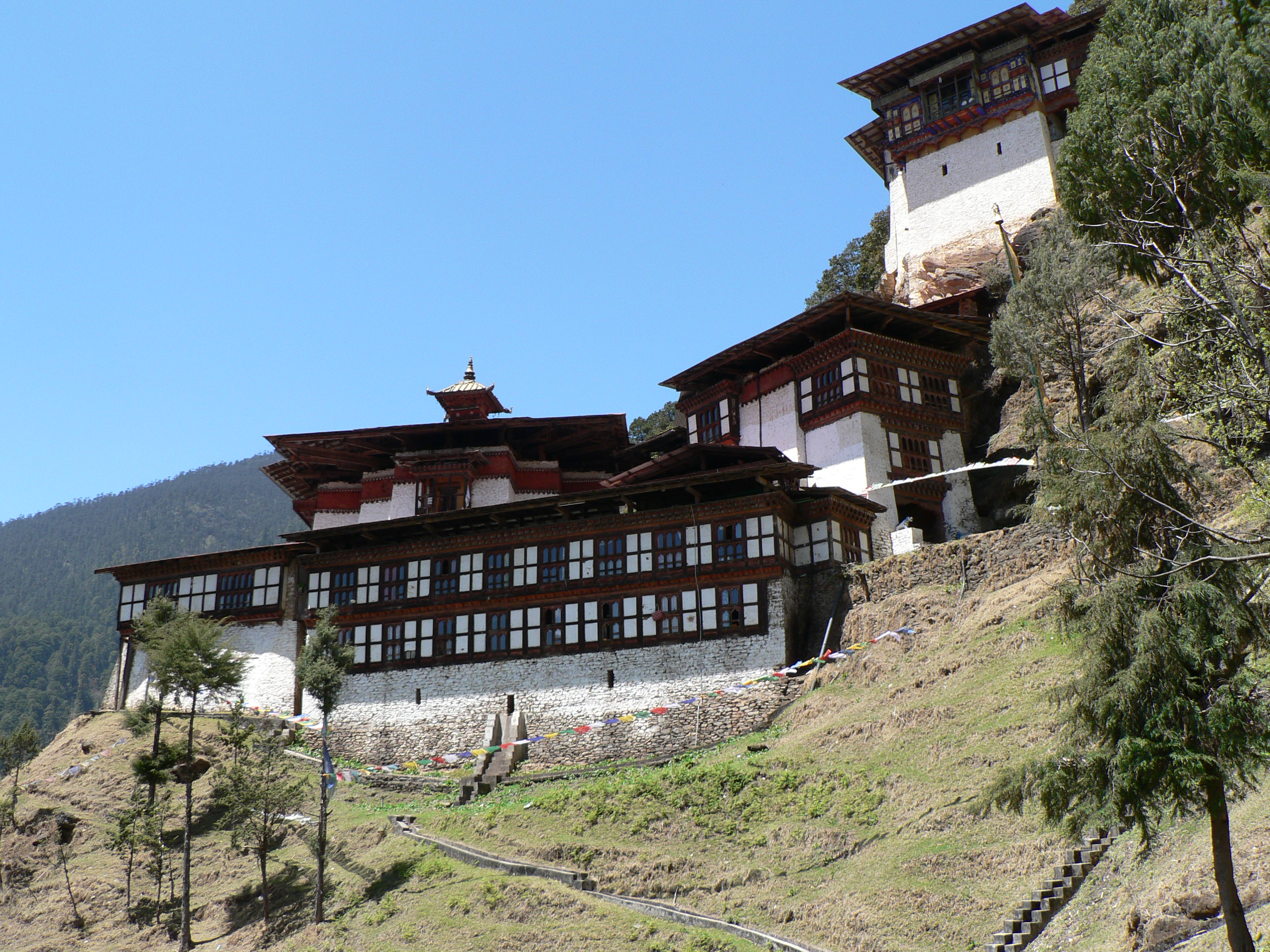Chagri Monastery on:
[Wikipedia]
[Google]
[Amazon]
Chagri Dorjeden Monastery, also called Cheri Monastery, is a Buddhist monastery in Bhutan established in 1620 by Ngawang Namgyal, 1st Zhabdrung Rinpoche, the founder of the Bhutanese state.
The monastery, now a major teaching and retreat center of the Southern  Chagri Dorjeden was the first monastery established in Bhutan by Ngawang Namgyal in 1620 when he was 27 years old. The Zhabdrung spent three years in a strict retreat at Chagri and resided there for many periods throughout the rest of his life. It was at Chagri in 1623 that he established the first Drukpa monastic order in Bhutan.
In 1705, the 7th Druk Desi, Umze Peljor, retired to Chagri Monastery, where he lived until he died in 1707.
Chagri Dorjeden was the first monastery established in Bhutan by Ngawang Namgyal in 1620 when he was 27 years old. The Zhabdrung spent three years in a strict retreat at Chagri and resided there for many periods throughout the rest of his life. It was at Chagri in 1623 that he established the first Drukpa monastic order in Bhutan.
In 1705, the 7th Druk Desi, Umze Peljor, retired to Chagri Monastery, where he lived until he died in 1707.
Formation of the State of Bhutan ('Brug gzhung) in the 17th century and its Tibetan Antecedents
''in'
Journal of Bhutan Studies
Vol 11 2004, Centre for Bhutan Studies, Thimphu. * Dargye, Yonten and Sørensen, P.K. (2001); ''The Biography of Pha 'Brug-sgom Zhig-po called The Current of Compassion.'' Thumphu:
National Library of Bhutan
. * * * *Johnsingh, A. J. T. 2005. A paradise in the Himalaya. ''Frontline'', January, 28: 67–72. Drukpa Kagyu monasteries and temples in Bhutan 1620 establishments in Bhutan 17th-century Buddhist temples {{Bhutan-Tibetan-Buddhism-monastery-stub
Drukpa Lineage
The Drukpa or Drukpa Kagyu () lineage, sometimes called Dugpa in older sources, is a branch of the Kagyu school of Tibetan Buddhism. The Kagyu school is one of the Sarma or "New Translation" schools of Tibetan Buddhism. The Drukpa lineage w ...
of the Kagyu school of Tibetan Buddhism
Tibetan Buddhism is a form of Buddhism practiced in Tibet, Bhutan and Mongolia. It also has a sizable number of adherents in the areas surrounding the Himalayas, including the Indian regions of Ladakh, Gorkhaland Territorial Administration, D ...
, is located at the northern end of the Thimphu Valley about from the capital. It sits on a hill above the end of the road at Dodeyna and it takes about an hour to walk up the steep hill to reach the monastery from there.
According to Bhutanese religious histories, the place was first visited by Padmasambhava
Padmasambhava ('Born from a Lotus'), also known as Guru Rinpoche ('Precious Guru'), was a legendary tantric Buddhist Vajracharya, Vajra master from Oddiyana. who fully revealed the Vajrayana in Tibet, circa 8th – 9th centuries... He is consi ...
in the 8th century. In the 13th century it was visited by Phajo Drugom Zhigpo the Tibetan Lama who first established the Drukpa Kagyu tradition in Bhutan. Johnsingh (2005) describes the beauty of the place and the occurrence of goral there.
 Chagri Dorjeden was the first monastery established in Bhutan by Ngawang Namgyal in 1620 when he was 27 years old. The Zhabdrung spent three years in a strict retreat at Chagri and resided there for many periods throughout the rest of his life. It was at Chagri in 1623 that he established the first Drukpa monastic order in Bhutan.
In 1705, the 7th Druk Desi, Umze Peljor, retired to Chagri Monastery, where he lived until he died in 1707.
Chagri Dorjeden was the first monastery established in Bhutan by Ngawang Namgyal in 1620 when he was 27 years old. The Zhabdrung spent three years in a strict retreat at Chagri and resided there for many periods throughout the rest of his life. It was at Chagri in 1623 that he established the first Drukpa monastic order in Bhutan.
In 1705, the 7th Druk Desi, Umze Peljor, retired to Chagri Monastery, where he lived until he died in 1707.
History
Cheri initiated a new chapter in the history of the Drukpa school. As soon as the temple was finished and the reliquary stupa installed, Zhabdrung introduced a monastic community of 30 monks according to the constitutional and procedural framework he had created for his first monastic community in Ralung. These monks and the lay devotees, who gathered in Cheri, were taught by Lhawang Lodoe, who passed down the Drukpa teachings transmitted to him by Pema Karpo. At the age of 33, he sent out edicts bearing his emblem of Ngachudruma, declaring 'all gods, humans and spirits of the Lhomonkhazhi, from this day, fall under the dominion of the great magician Nagwang Namgyal and everyone must heed to his words'.References
Sources
* * Ardussi, John (2004);Formation of the State of Bhutan ('Brug gzhung) in the 17th century and its Tibetan Antecedents
''in'
Journal of Bhutan Studies
Vol 11 2004, Centre for Bhutan Studies, Thimphu. * Dargye, Yonten and Sørensen, P.K. (2001); ''The Biography of Pha 'Brug-sgom Zhig-po called The Current of Compassion.'' Thumphu:
National Library of Bhutan
. * * * *Johnsingh, A. J. T. 2005. A paradise in the Himalaya. ''Frontline'', January, 28: 67–72. Drukpa Kagyu monasteries and temples in Bhutan 1620 establishments in Bhutan 17th-century Buddhist temples {{Bhutan-Tibetan-Buddhism-monastery-stub